I am still recovering from the cold I caught on the return train from Varanasi ( BSB). But I wanted to share the story of our recent trip to Kashi or Benares or the home of Benarasi sarees which are an essential part of Bengali marriages. If you grew up with movies like Jai Baba Felunath, then you are already familiar with Benaras Ghats.
Varanasi, also known as Kashi, has approximately 84 Ghats. Each Ghat has its own unique history, significance, and attractions. Some Ghats are used for bathing and ritual purification, while others are used for cremation ceremonies. Some of the most famous Ghats in Varanasi include:
- Dashashwamedh Ghat: This is the main Ghat in Varanasi, and it is believed to be the site where Lord Brahma performed a yagna.
- Manikarnika Ghat: This is the most important Ghat for cremation ceremonies in Varanasi.
- Assi Ghat: This Ghat is located at the confluence of the Ganges and Assi rivers and is considered a sacred spot by Hindus. The belief is that after a battle with Sumbh and Nisumbh, Devi Durga dropped her sword here, and the Assi river was born.
- Manmandir Ghat: This Ghat was built by Raja Man Singh of Amber, and it has a palace.
- Scindhia Ghat: This Ghat was built by the Scindhia dynasty of Gwalior, and it has a temple dedicated to Lord Shiva.
- Panchganga Ghat: This Ghat is one of the most ancient Ghats in Varanasi; it is said that five rivers meet here.
- Harishchandra Ghat: This Ghat is considered one of the most sacred spots for performing the last rites of the deceased.
Our hotel was about 5 minute walk from Harishchandra Ghat. Most of the ghats are connected. So after reaching Kedar / Harishchandra ghat, we could walk on our right and reach Assi ghat, and if we took a left, we could reach the Dashaswamedh ghat. Most of the ghats have an inscription describing the significance behind the name of the ghat. I highly recommend you read those.
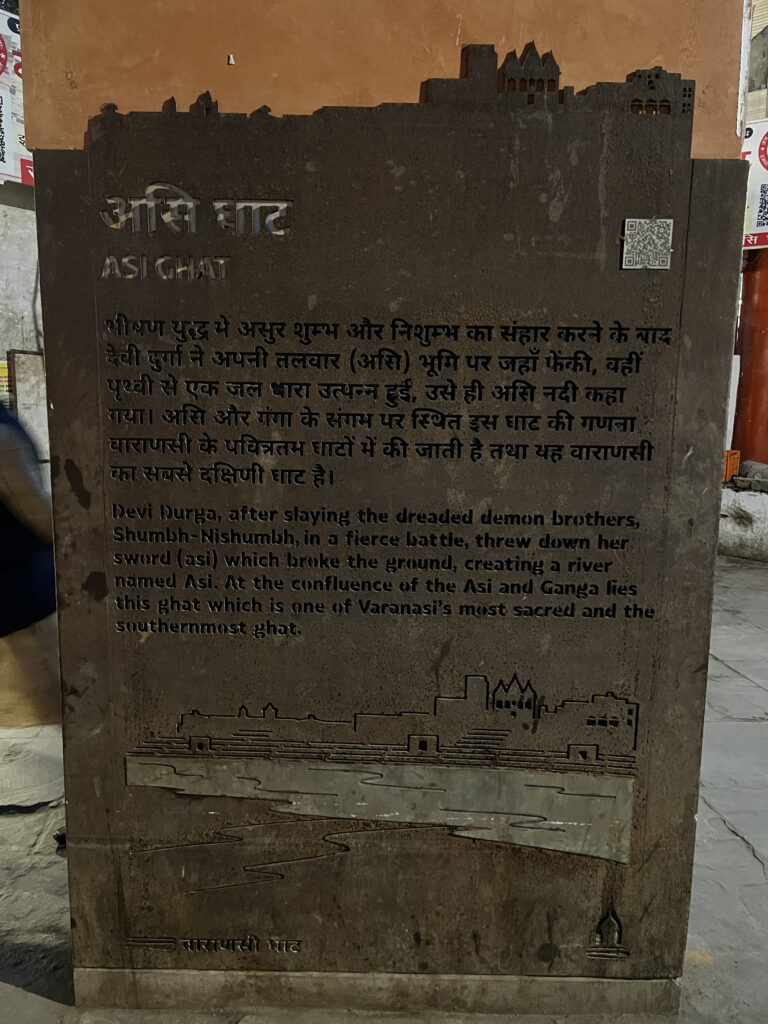
The ghats are steep, and make sure you have good cardio health before you decide to go up and down. And the ghats are clean, clean enough to lie down and have a sunbath, although I recommend against it.
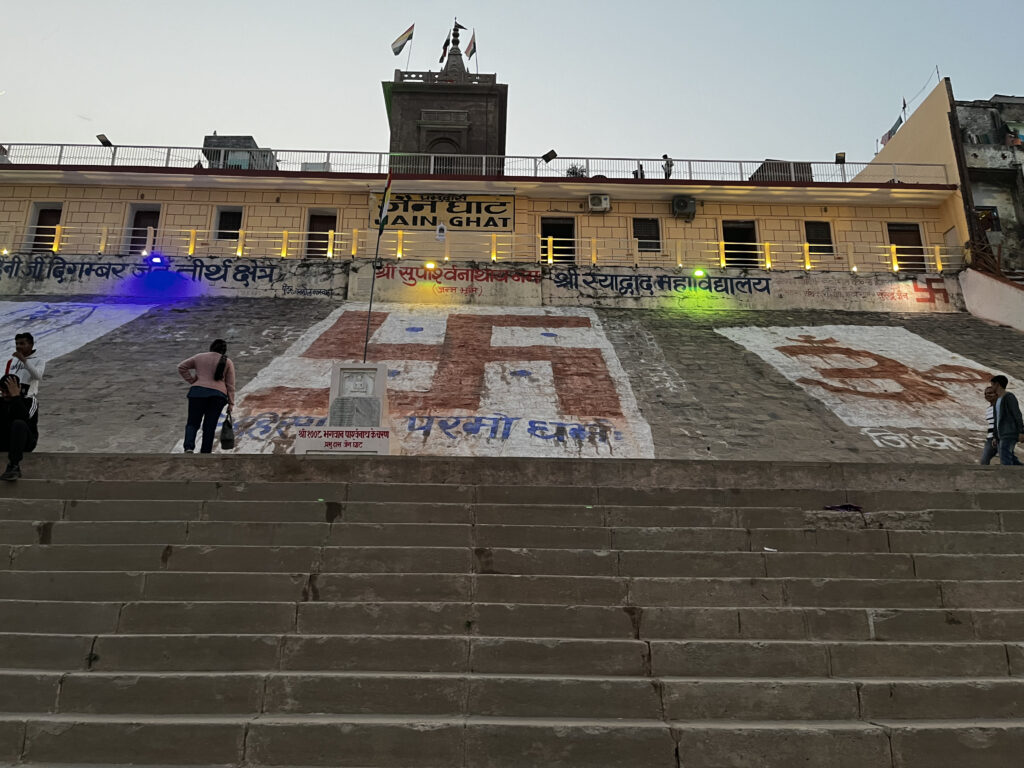
Varanasi, also known as Kashi or Benares, is one of the oldest continuously inhabited cities in the world. It is believed to be over 3,000 years old. The city is mentioned in ancient Hindu texts, such as the Skanda Purana and the Ramayana, and it is considered one of the seven sacred cities in Hinduism. The city is also associated with Buddhism, as it is believed that the Buddha gave his first sermon in Varanasi. Throughout history, Varanasi has been a center of religious, cultural, and intellectual activity, and it continues to be an important pilgrimage site for Hindus today.
Varanasi is home to many temples; some of the most famous and influential temples in the city are:
Kashi Vishwanath Temple: This temple is one of the most sacred Hindu temples in the city, dedicated to Lord Shiva. It is also known as the Golden Temple due to the gold plating on its central dome.
Sankat Mochan Hanuman Temple: This temple is dedicated to Lord Hanuman, the monkey god, and is considered one of the most powerful temples in the city.
New Vishwanath Temple: This temple is located inside the Banaras Hindu University and is dedicated to Lord Shiva.
Durga Temple: This temple is also known as the Monkey Temple, as it is said to be home to many monkeys. It is dedicated to the Hindu goddess Durga.
Annapoorna Temple: This temple is dedicated to Annapoorna, the Hindu goddess of food and nourishment.
Tulsi Manas Temple: This temple is dedicated to Lord Rama and was built where the famous saint-poet Tulsidas wrote the Ramcharitmanas.
Sarnath Buddhist Temple: This temple is located in Sarnath, a suburb of Varanasi, where the Buddha gave his first sermon, and it is an important pilgrimage site for Buddhists.
These are just a few of the many temples in Varanasi, and there are many more to explore and discover in the city. We were walking towards the Dashaswamedh ghat from godowlia chauraha and I found a temple for Brihaspati. It was truly unique.
Day 1:
We landed in Varanasi, JN, around 2.30 am. The train was at the right time. We were traveling in 2 tier and as a side effect, I could not shut my eyes. After reaching there, we crashed into the railway’s dorm room. The lady who was supposed to allocate beds to us was deep asleep. So I and my wife crashed into one single bed. Around 7 am, when the smog was putting up the last fight with sun light, we decided to get out of the dorm and find a hotel. Although we had booked the check-in time at 12 pm, the hotel was asking for extra 1000 rs to let us check in at 8 am.
We took an auto and started towards Ghat. We found a Hotel which let us check in the morning at 7.15 am and did not charge anything extra. We took a bath and changed. And started for Kashi Biswanath around 9 am.
Visiting the Kashi Vishwanath Temple: This is one of the most important temples in Varanasi, dedicated to Lord Shiva. We got a guide who found a priest for us. Before entering the temple, you must keep your mobile and shoes deposited; lockers are inside the temple. We kept it in a shop.
I recommend that you go directly to the temple and get a priority pass; that way, you can save money. The top of the temple is made with Gold, donated by Punjab’s king Ranjit Singh and I recently heard someone donated 15kg of gold for the interior.
We came back to the hotel and immediately started for Sarnath in Auto. On our way to Sarnath, the driver, on request, took us to a Mallyoo shop, we had 2 glasses of kesar milk ( 20rs per glass), and then we went to paan shop for Banarasi paan, which cost me 25rs. After visiting the stupas and a Shiva temple with two lingas we came back to the hotel. The auto charged us 600 rs.
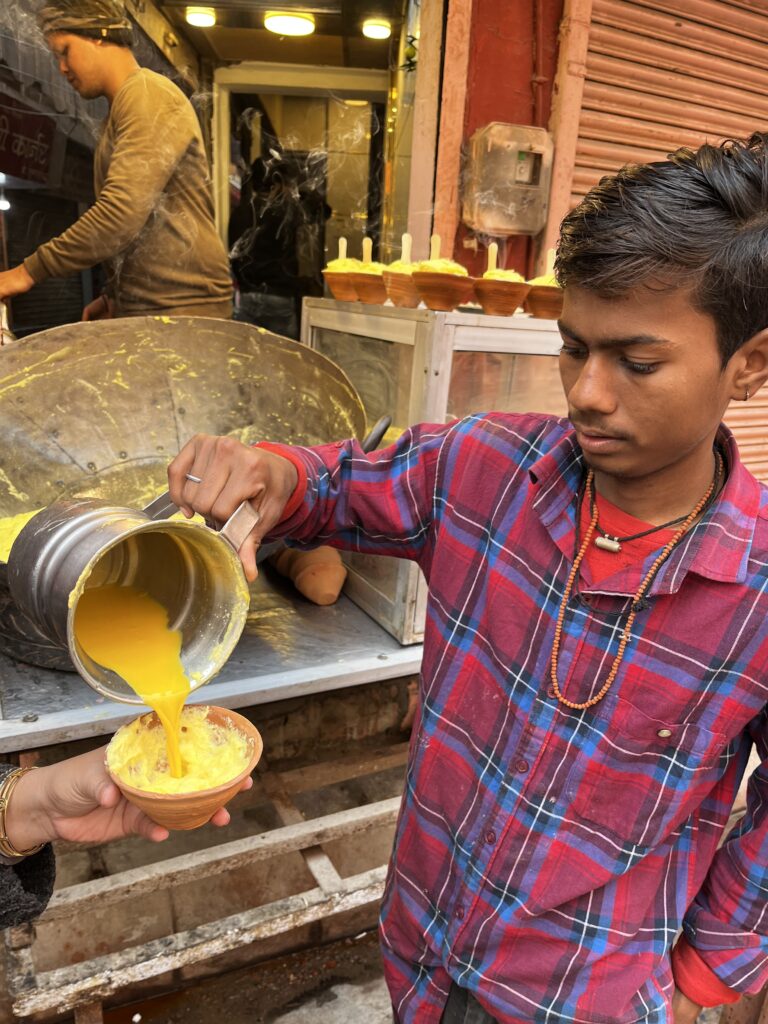
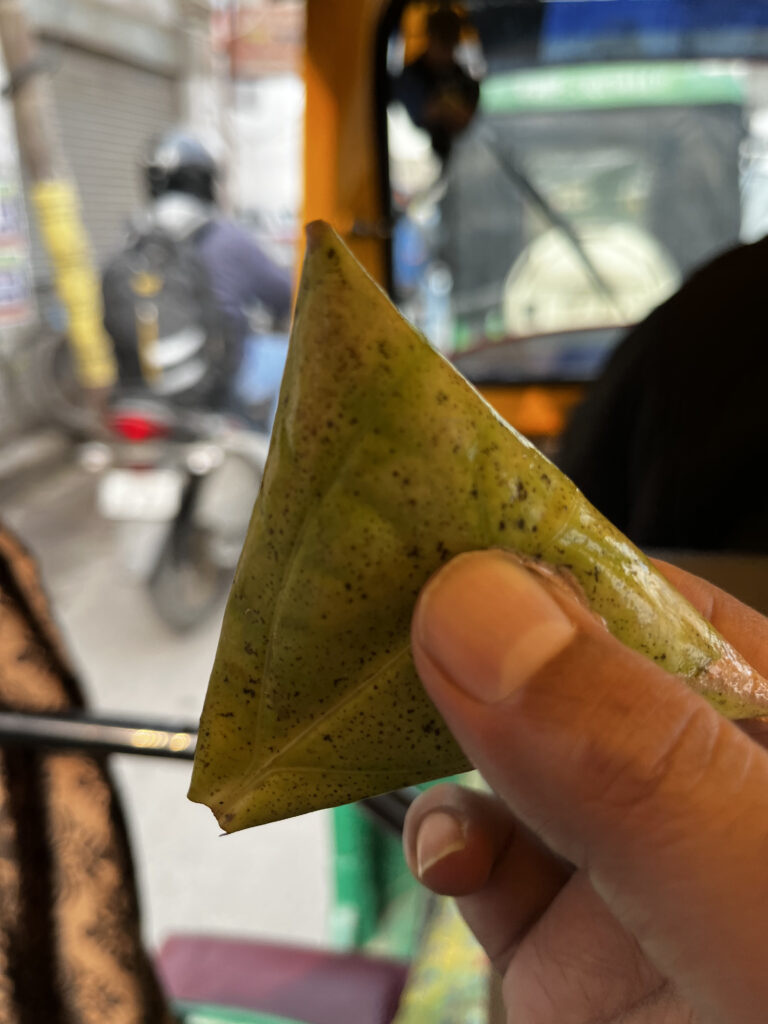
The Ganga aarti starts around 7 pm. So we had some time. We got a guide in a hotel called Gopal. He took us to the Kedar Ghat through the famous Benarasi gully. After reaching there, we found out that there were no boats, and we decided to walk to Dasawsamedh ghat. We were in the ghat during the Aarti. There were few boats one could hire to see the Aarti, and there were seats on decks on static boats sold for 200rs. I highly recommend this. Without seeing the Aarti, your Benaras trip will not be completed. After this, we returned to Godowhlia churaha and had chaat from the famous Kashi chaat Bandar. And we went to the saffron restaurant to have dinner to conclude the day.
Day 2:
We had contact with a Bengali person who rents out cars with a driver. I made the call around 7.30 am. I asked how much he would charge to Take us to Prayagraj Sangam, he said 4000 rs. And for another 800 rs, he agreed to add Bindhyachal. We visited Bindhyachal first, and then we went off to Prayagraj.
A boat ride to Triveni Sangam starts from 2000 rs. But remember, it is 1.5 km boat ride. So I was not going to pay that much. I kind of thought of paying 600 rs in a shared ride. Some brokers approach you the moment you reach the parking area. One broker agreed to 800 rs—eight hundred rs for the boat ride and 300 rs for the broker to keep. We were not going to bathe. And one point we missed was offering puja to Ganga, Jamuna, and Saraswati rivers. They take you to Sangam, and you will find a priest there. Now that you have the information, you can tell them upfront that you don’t want to offer puja.
After coming back from Tribeni, we quickly checked out the hanuman temple. It is famous as Hanumanji is in a lying down position.
We started towards Varanasi. We had our lunch in a restaurant. And we paid for the driver’s lunch, in case you were wondering who pays. After reaching Varanasi, when it was dark outside, we went to Sankat Mochan and Durga Mandir. We paid 5000 rs for the entire trip to the car guy.
After returning to the hotel, we went to Ksheer Sagar, for Peda, a sweet that is famous here in Kolkata. We got some all peda 400rs a kg and white peda for 600rs a KG
We were too tired to go out for dinner that night, so we ordered from the hotel, and to our surprise, we were happy with the price and quantity. And that is how we concluded our day 2 in Varanasi.
At this point in time, we recounted what else was pending. I wanted to visit some more ghats. We tasted Malayoo and the kesar milk already near Kashi Biswanath.
We had kachori for breakfast on day two morning. We had some famous pink inside guava. We had famous chaats. I wanted to try lassi, thandai, and rabri.
Day 3
Our train was at 9 pm. This itself created a challenge as we needed an extended checkout. So I spoke to reception, and they agreed to half-day rent to give us a late checkout. Now it was time to get out and go to KalBhairav temple. We got an auto to Kalvairav it charged us 350rs. The auto driver suggested we visit the local Mughal market where Banarasi sarees are sold wholesale going to Godowlia shops. But since we did not know that person, we could not trust him. And we came back to the hotel.
In the hotel, when we asked the reception where to buy sarees, they took us to a shop, and we were happy with the price and the quality we got there. We purchased around four sarees and came back to the hotel.
Now was the time to go out for thandai, lasi and rabri. The first thing we got our hands on was thandai. We took the normal one, 80rs a glass. It was first time I had something like this. And I do recommend you try it out. There are different flavours and if someone wants a high they can request for vang to be added. The place we tried the thandai was in Godowalia chouraha, called “Mishrambu”.
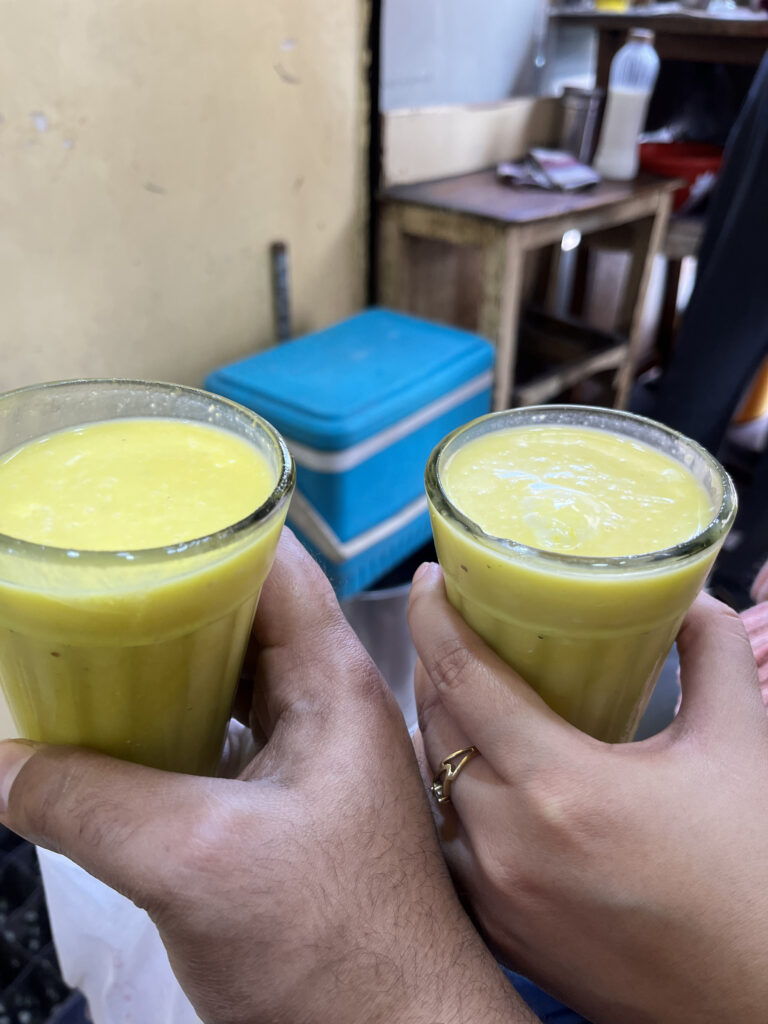
Next, we went to Lassi. Unfortunately, I did not take a picture of it. But it was different from how I knew lassi to be. It was served in a earthen cup and the full size was for 30rs.
After that, it was time for lunch and rest. We ordered noodles. Most of the menu cards will tell you that all the foods sold in Benaras are veg, but if you want non-vegetarian food, you can ask the restaurant. Because when we were waiting in the reception area of our hotel, we saw a family ordering non-veg food. But for people who do not eat non-veg, I will not be sure about their cooking skills.
Anyway, as we were getting ready to go out to the station, it was already 5 pm. Our train was at 9 pm. So I wanted to go out for one more round for ghat hopping. And we went out towards Assi ghat. Although I am not 100% sure, I believe in Assi ghat a Ganga Aarti gets performed.
We took a boat from Assi ghat to Dasaswamedh ghat, and we requested to the boatman to drop us at Kedar ghat. For us 2, he charged 500rs. One thing you need to remember, you will have to bargain everywhere. But you cannot bargain in sweet shops. In case you forgot, we were yet to get Rabdi, which you can get only in the afternoons. And you do not or cannot bargain at these shops. And unfortunately, I do not exactly remember the price for Rabdi.
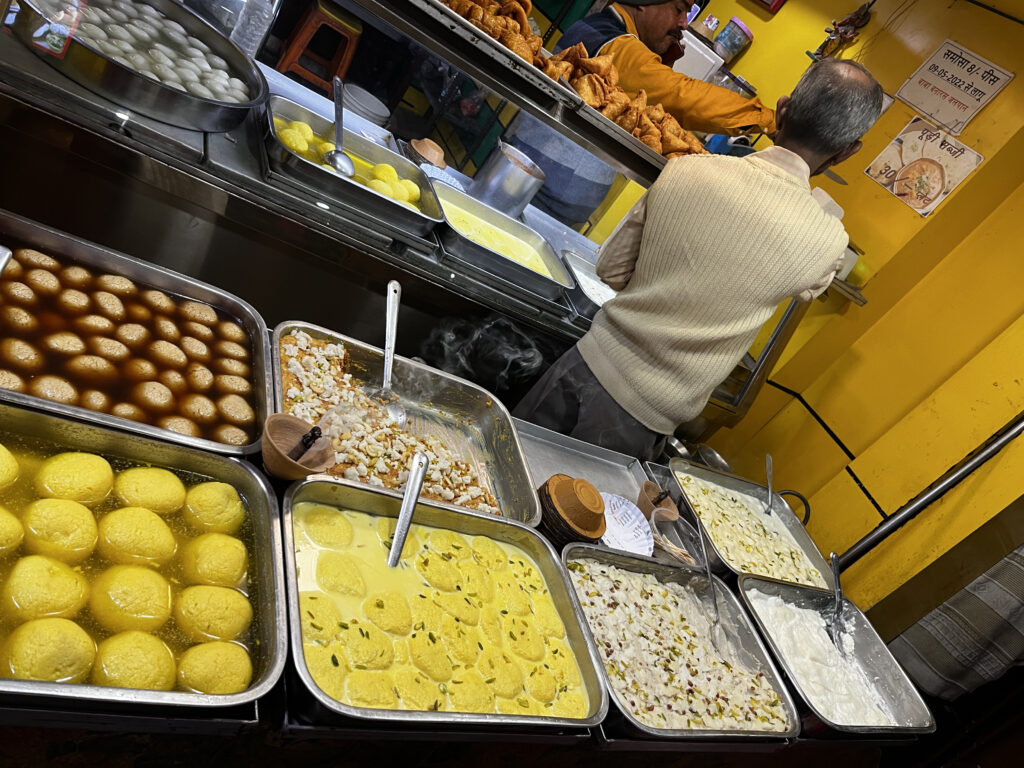
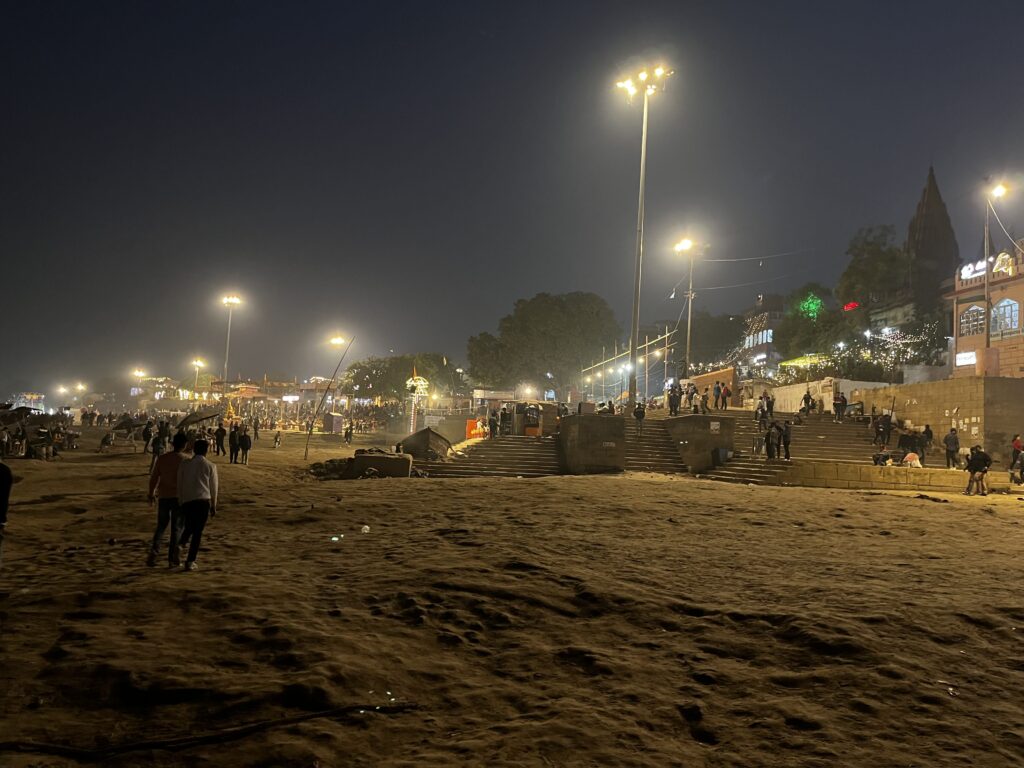
We came back to the hotel and checked out. Before checking out, we asked the reception person how much the auto would charge us to the station. And they said 150rs. So the moment we saw an auto he asked for 200rs and agreed to 150rs.
The auto dropped us near the station. Do not bring a car to Varanasi. The traffic is terrible, and the roads are narrow. Gully’s are narrow, and you will find scooters, bulls, and everything else that could fit in. And that’s pretty much it we did in Varanasi in 3 days.

